ECO Homework: Data Wish List to Assess KAUST's Impact on Saudi Arabia
VerifiedAdded on 2023/04/06
|7
|1354
|51
Homework Assignment
AI Summary
This assignment focuses on identifying the data required to analyze King Abdullah University of Science and Technology's (KAUST) impact on Saudi Arabia's economy, particularly in relation to Saudi Vision 2030. The student outlines five key objectives for KAUST: helping Saudi Arabia realize a diversified technology-based economy, accelerating commercialization, supporting early investments in new business technology, advancing science and technology, and addressing national priorities. A balance scorecard is presented with achievements for each objective. Due to the lack of available data for a comprehensive analysis, the assignment pivots to creating a 'wish list' of data points that would enable a robust economic analysis of KAUST's contributions, including the impact of technologies like Uber and Careem, the commercialization of innovations, and the university's role in fostering startups and attracting investments. The student also considers the number of patents, inventions, and projects aligned with Saudi's Vision 2030.
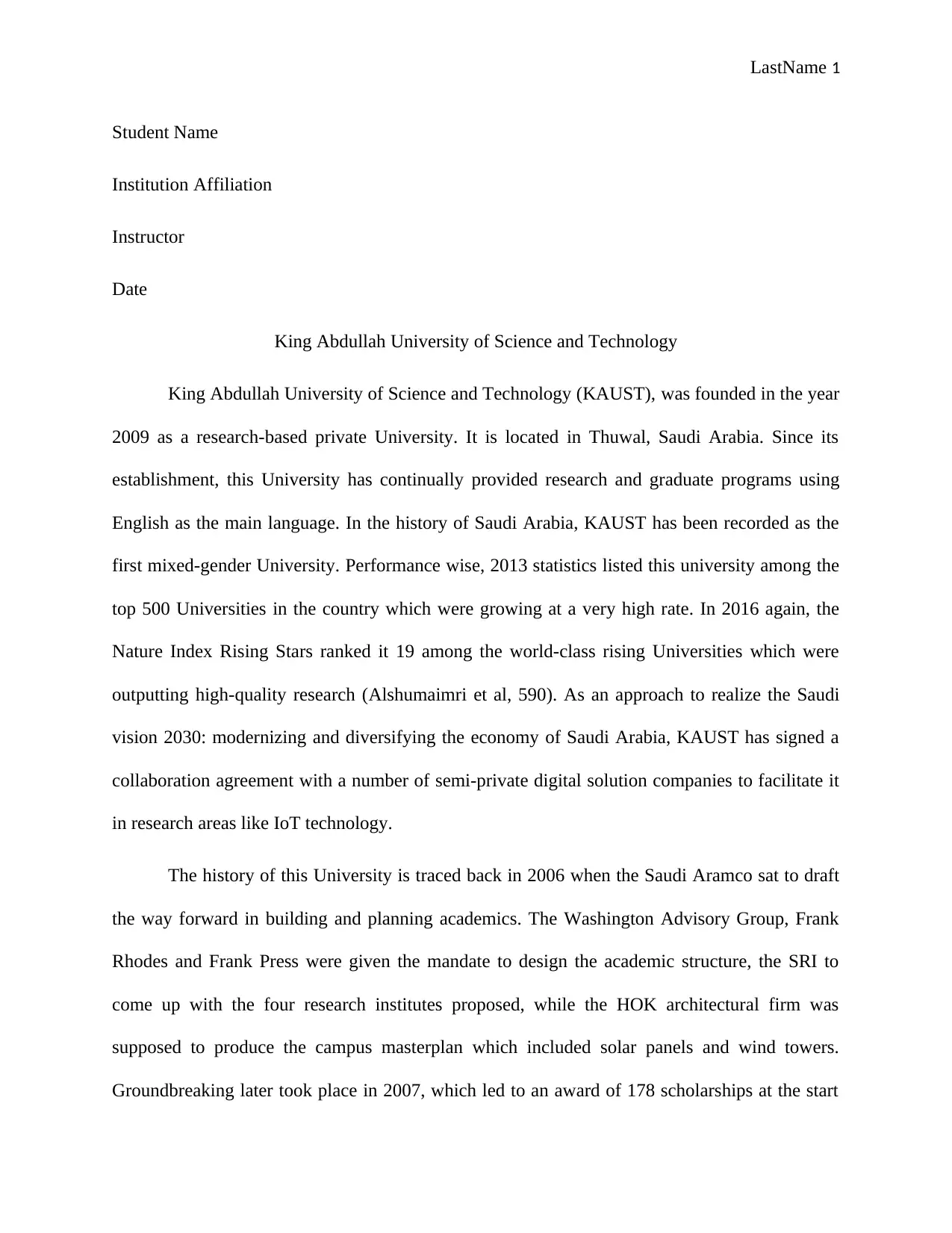
LastName 1
Student Name
Institution Affiliation
Instructor
Date
King Abdullah University of Science and Technology
King Abdullah University of Science and Technology (KAUST), was founded in the year
2009 as a research-based private University. It is located in Thuwal, Saudi Arabia. Since its
establishment, this University has continually provided research and graduate programs using
English as the main language. In the history of Saudi Arabia, KAUST has been recorded as the
first mixed-gender University. Performance wise, 2013 statistics listed this university among the
top 500 Universities in the country which were growing at a very high rate. In 2016 again, the
Nature Index Rising Stars ranked it 19 among the world-class rising Universities which were
outputting high-quality research (Alshumaimri et al, 590). As an approach to realize the Saudi
vision 2030: modernizing and diversifying the economy of Saudi Arabia, KAUST has signed a
collaboration agreement with a number of semi-private digital solution companies to facilitate it
in research areas like IoT technology.
The history of this University is traced back in 2006 when the Saudi Aramco sat to draft
the way forward in building and planning academics. The Washington Advisory Group, Frank
Rhodes and Frank Press were given the mandate to design the academic structure, the SRI to
come up with the four research institutes proposed, while the HOK architectural firm was
supposed to produce the campus masterplan which included solar panels and wind towers.
Groundbreaking later took place in 2007, which led to an award of 178 scholarships at the start
Student Name
Institution Affiliation
Instructor
Date
King Abdullah University of Science and Technology
King Abdullah University of Science and Technology (KAUST), was founded in the year
2009 as a research-based private University. It is located in Thuwal, Saudi Arabia. Since its
establishment, this University has continually provided research and graduate programs using
English as the main language. In the history of Saudi Arabia, KAUST has been recorded as the
first mixed-gender University. Performance wise, 2013 statistics listed this university among the
top 500 Universities in the country which were growing at a very high rate. In 2016 again, the
Nature Index Rising Stars ranked it 19 among the world-class rising Universities which were
outputting high-quality research (Alshumaimri et al, 590). As an approach to realize the Saudi
vision 2030: modernizing and diversifying the economy of Saudi Arabia, KAUST has signed a
collaboration agreement with a number of semi-private digital solution companies to facilitate it
in research areas like IoT technology.
The history of this University is traced back in 2006 when the Saudi Aramco sat to draft
the way forward in building and planning academics. The Washington Advisory Group, Frank
Rhodes and Frank Press were given the mandate to design the academic structure, the SRI to
come up with the four research institutes proposed, while the HOK architectural firm was
supposed to produce the campus masterplan which included solar panels and wind towers.
Groundbreaking later took place in 2007, which led to an award of 178 scholarships at the start
Paraphrase This Document
Need a fresh take? Get an instant paraphrase of this document with our AI Paraphraser
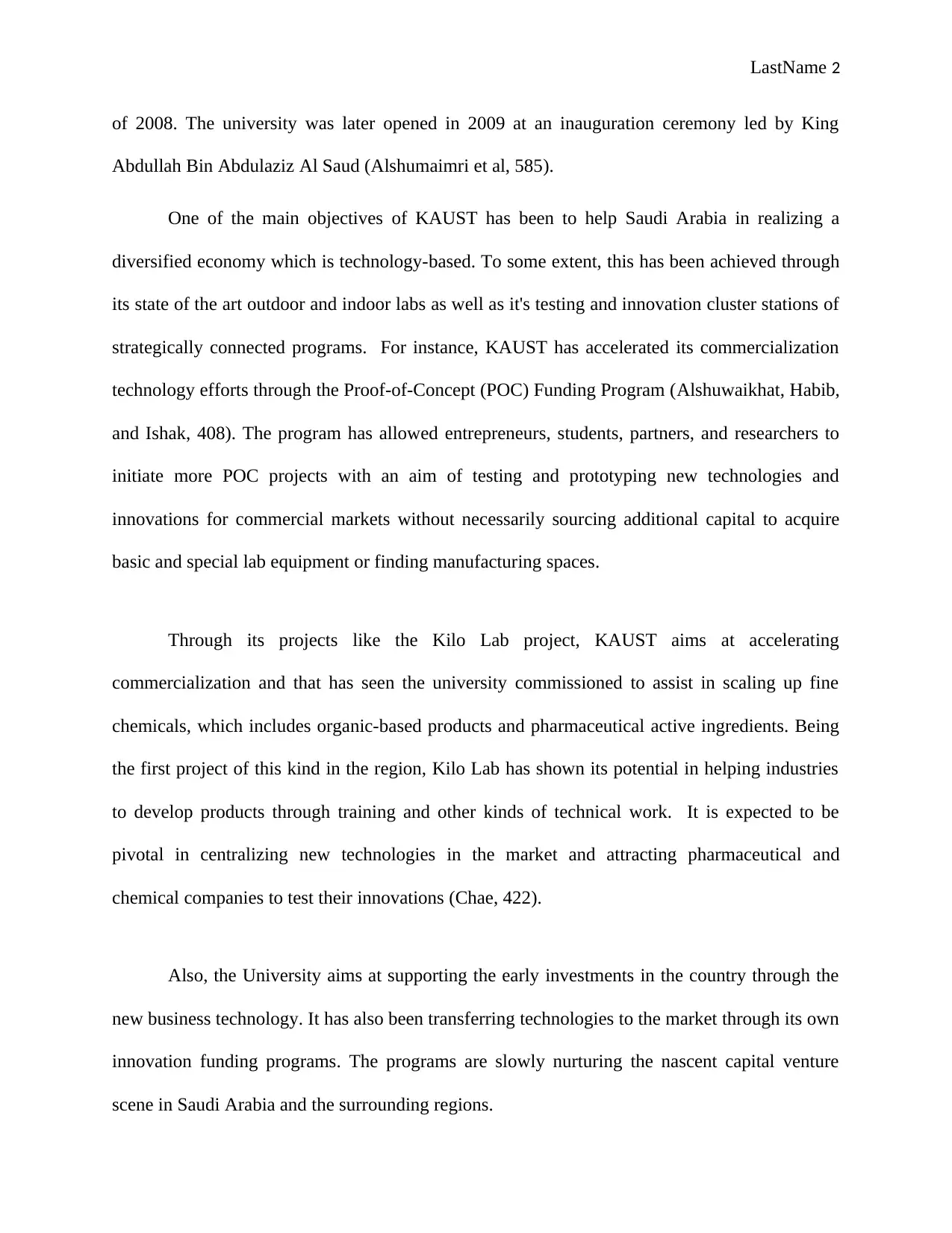
LastName 2
of 2008. The university was later opened in 2009 at an inauguration ceremony led by King
Abdullah Bin Abdulaziz Al Saud (Alshumaimri et al, 585).
One of the main objectives of KAUST has been to help Saudi Arabia in realizing a
diversified economy which is technology-based. To some extent, this has been achieved through
its state of the art outdoor and indoor labs as well as it's testing and innovation cluster stations of
strategically connected programs. For instance, KAUST has accelerated its commercialization
technology efforts through the Proof-of-Concept (POC) Funding Program (Alshuwaikhat, Habib,
and Ishak, 408). The program has allowed entrepreneurs, students, partners, and researchers to
initiate more POC projects with an aim of testing and prototyping new technologies and
innovations for commercial markets without necessarily sourcing additional capital to acquire
basic and special lab equipment or finding manufacturing spaces.
Through its projects like the Kilo Lab project, KAUST aims at accelerating
commercialization and that has seen the university commissioned to assist in scaling up fine
chemicals, which includes organic-based products and pharmaceutical active ingredients. Being
the first project of this kind in the region, Kilo Lab has shown its potential in helping industries
to develop products through training and other kinds of technical work. It is expected to be
pivotal in centralizing new technologies in the market and attracting pharmaceutical and
chemical companies to test their innovations (Chae, 422).
Also, the University aims at supporting the early investments in the country through the
new business technology. It has also been transferring technologies to the market through its own
innovation funding programs. The programs are slowly nurturing the nascent capital venture
scene in Saudi Arabia and the surrounding regions.
of 2008. The university was later opened in 2009 at an inauguration ceremony led by King
Abdullah Bin Abdulaziz Al Saud (Alshumaimri et al, 585).
One of the main objectives of KAUST has been to help Saudi Arabia in realizing a
diversified economy which is technology-based. To some extent, this has been achieved through
its state of the art outdoor and indoor labs as well as it's testing and innovation cluster stations of
strategically connected programs. For instance, KAUST has accelerated its commercialization
technology efforts through the Proof-of-Concept (POC) Funding Program (Alshuwaikhat, Habib,
and Ishak, 408). The program has allowed entrepreneurs, students, partners, and researchers to
initiate more POC projects with an aim of testing and prototyping new technologies and
innovations for commercial markets without necessarily sourcing additional capital to acquire
basic and special lab equipment or finding manufacturing spaces.
Through its projects like the Kilo Lab project, KAUST aims at accelerating
commercialization and that has seen the university commissioned to assist in scaling up fine
chemicals, which includes organic-based products and pharmaceutical active ingredients. Being
the first project of this kind in the region, Kilo Lab has shown its potential in helping industries
to develop products through training and other kinds of technical work. It is expected to be
pivotal in centralizing new technologies in the market and attracting pharmaceutical and
chemical companies to test their innovations (Chae, 422).
Also, the University aims at supporting the early investments in the country through the
new business technology. It has also been transferring technologies to the market through its own
innovation funding programs. The programs are slowly nurturing the nascent capital venture
scene in Saudi Arabia and the surrounding regions.
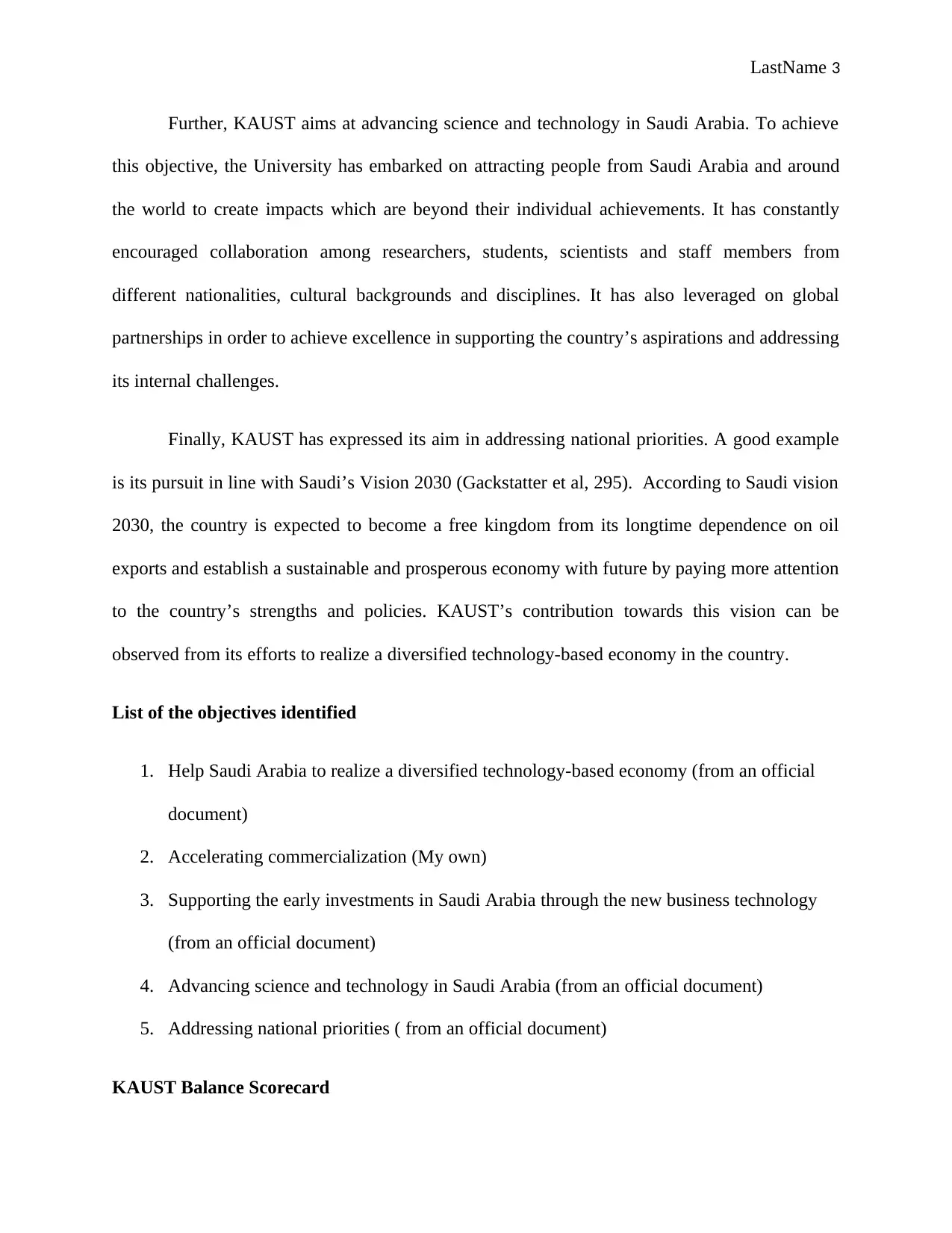
LastName 3
Further, KAUST aims at advancing science and technology in Saudi Arabia. To achieve
this objective, the University has embarked on attracting people from Saudi Arabia and around
the world to create impacts which are beyond their individual achievements. It has constantly
encouraged collaboration among researchers, students, scientists and staff members from
different nationalities, cultural backgrounds and disciplines. It has also leveraged on global
partnerships in order to achieve excellence in supporting the country’s aspirations and addressing
its internal challenges.
Finally, KAUST has expressed its aim in addressing national priorities. A good example
is its pursuit in line with Saudi’s Vision 2030 (Gackstatter et al, 295). According to Saudi vision
2030, the country is expected to become a free kingdom from its longtime dependence on oil
exports and establish a sustainable and prosperous economy with future by paying more attention
to the country’s strengths and policies. KAUST’s contribution towards this vision can be
observed from its efforts to realize a diversified technology-based economy in the country.
List of the objectives identified
1. Help Saudi Arabia to realize a diversified technology-based economy (from an official
document)
2. Accelerating commercialization (My own)
3. Supporting the early investments in Saudi Arabia through the new business technology
(from an official document)
4. Advancing science and technology in Saudi Arabia (from an official document)
5. Addressing national priorities ( from an official document)
KAUST Balance Scorecard
Further, KAUST aims at advancing science and technology in Saudi Arabia. To achieve
this objective, the University has embarked on attracting people from Saudi Arabia and around
the world to create impacts which are beyond their individual achievements. It has constantly
encouraged collaboration among researchers, students, scientists and staff members from
different nationalities, cultural backgrounds and disciplines. It has also leveraged on global
partnerships in order to achieve excellence in supporting the country’s aspirations and addressing
its internal challenges.
Finally, KAUST has expressed its aim in addressing national priorities. A good example
is its pursuit in line with Saudi’s Vision 2030 (Gackstatter et al, 295). According to Saudi vision
2030, the country is expected to become a free kingdom from its longtime dependence on oil
exports and establish a sustainable and prosperous economy with future by paying more attention
to the country’s strengths and policies. KAUST’s contribution towards this vision can be
observed from its efforts to realize a diversified technology-based economy in the country.
List of the objectives identified
1. Help Saudi Arabia to realize a diversified technology-based economy (from an official
document)
2. Accelerating commercialization (My own)
3. Supporting the early investments in Saudi Arabia through the new business technology
(from an official document)
4. Advancing science and technology in Saudi Arabia (from an official document)
5. Addressing national priorities ( from an official document)
KAUST Balance Scorecard
⊘ This is a preview!⊘
Do you want full access?
Subscribe today to unlock all pages.

Trusted by 1+ million students worldwide
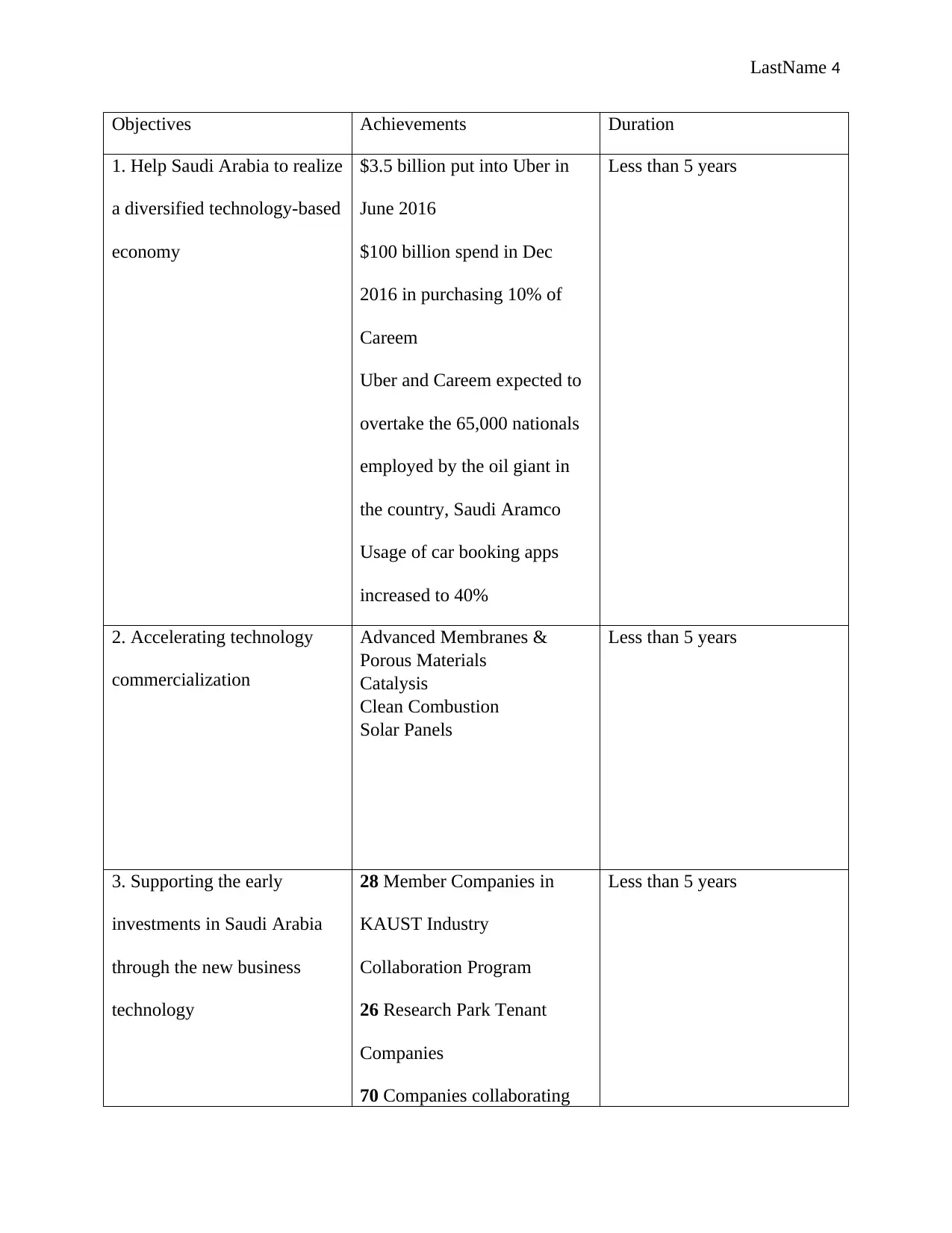
LastName 4
Objectives Achievements Duration
1. Help Saudi Arabia to realize
a diversified technology-based
economy
$3.5 billion put into Uber in
June 2016
$100 billion spend in Dec
2016 in purchasing 10% of
Careem
Uber and Careem expected to
overtake the 65,000 nationals
employed by the oil giant in
the country, Saudi Aramco
Usage of car booking apps
increased to 40%
Less than 5 years
2. Accelerating technology
commercialization
Advanced Membranes &
Porous Materials
Catalysis
Clean Combustion
Solar Panels
Less than 5 years
3. Supporting the early
investments in Saudi Arabia
through the new business
technology
28 Member Companies in
KAUST Industry
Collaboration Program
26 Research Park Tenant
Companies
70 Companies collaborating
Less than 5 years
Objectives Achievements Duration
1. Help Saudi Arabia to realize
a diversified technology-based
economy
$3.5 billion put into Uber in
June 2016
$100 billion spend in Dec
2016 in purchasing 10% of
Careem
Uber and Careem expected to
overtake the 65,000 nationals
employed by the oil giant in
the country, Saudi Aramco
Usage of car booking apps
increased to 40%
Less than 5 years
2. Accelerating technology
commercialization
Advanced Membranes &
Porous Materials
Catalysis
Clean Combustion
Solar Panels
Less than 5 years
3. Supporting the early
investments in Saudi Arabia
through the new business
technology
28 Member Companies in
KAUST Industry
Collaboration Program
26 Research Park Tenant
Companies
70 Companies collaborating
Less than 5 years
Paraphrase This Document
Need a fresh take? Get an instant paraphrase of this document with our AI Paraphraser
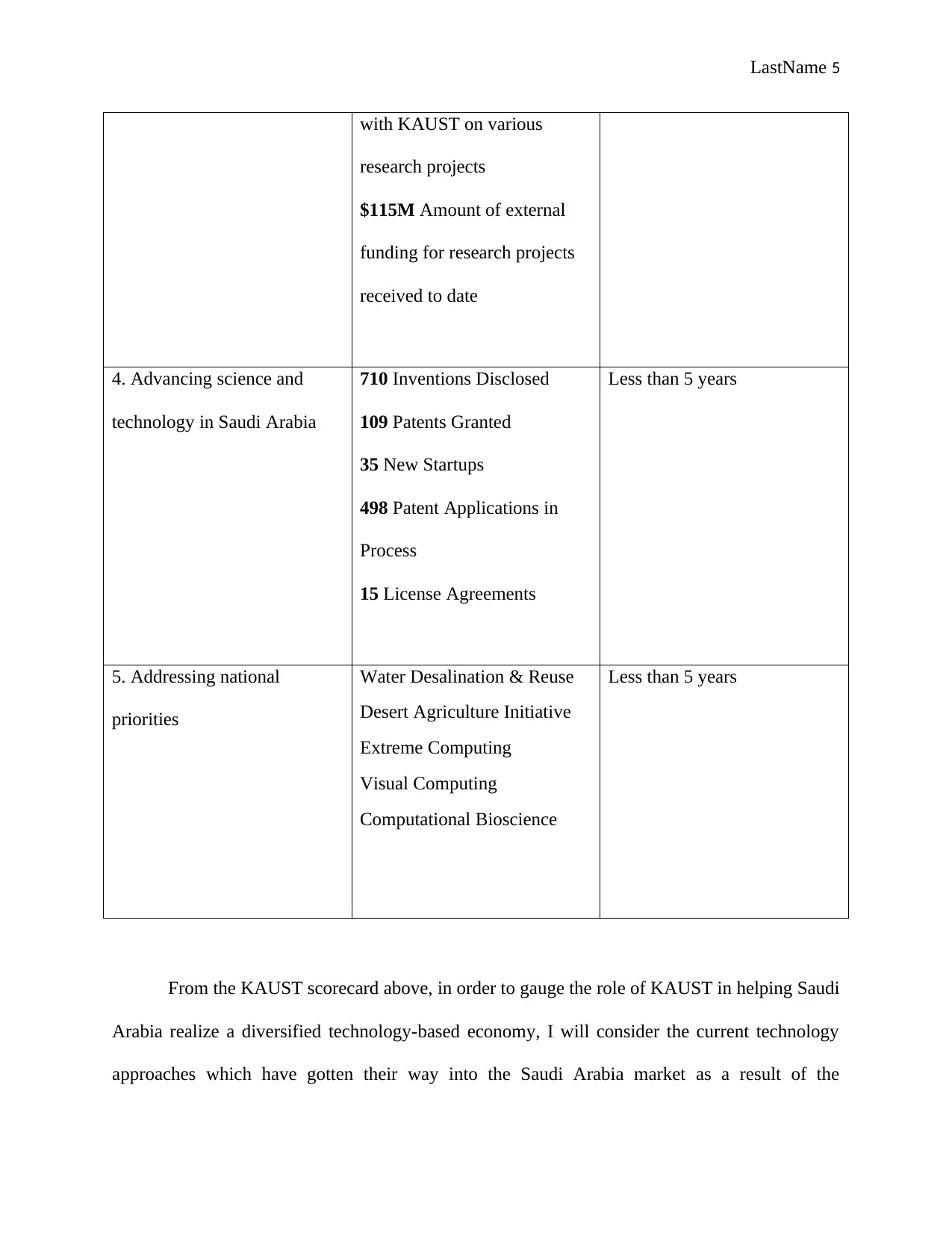
LastName 5
with KAUST on various
research projects
$115M Amount of external
funding for research projects
received to date
4. Advancing science and
technology in Saudi Arabia
710 Inventions Disclosed
109 Patents Granted
35 New Startups
498 Patent Applications in
Process
15 License Agreements
Less than 5 years
5. Addressing national
priorities
Water Desalination & Reuse
Desert Agriculture Initiative
Extreme Computing
Visual Computing
Computational Bioscience
Less than 5 years
From the KAUST scorecard above, in order to gauge the role of KAUST in helping Saudi
Arabia realize a diversified technology-based economy, I will consider the current technology
approaches which have gotten their way into the Saudi Arabia market as a result of the
with KAUST on various
research projects
$115M Amount of external
funding for research projects
received to date
4. Advancing science and
technology in Saudi Arabia
710 Inventions Disclosed
109 Patents Granted
35 New Startups
498 Patent Applications in
Process
15 License Agreements
Less than 5 years
5. Addressing national
priorities
Water Desalination & Reuse
Desert Agriculture Initiative
Extreme Computing
Visual Computing
Computational Bioscience
Less than 5 years
From the KAUST scorecard above, in order to gauge the role of KAUST in helping Saudi
Arabia realize a diversified technology-based economy, I will consider the current technology
approaches which have gotten their way into the Saudi Arabia market as a result of the
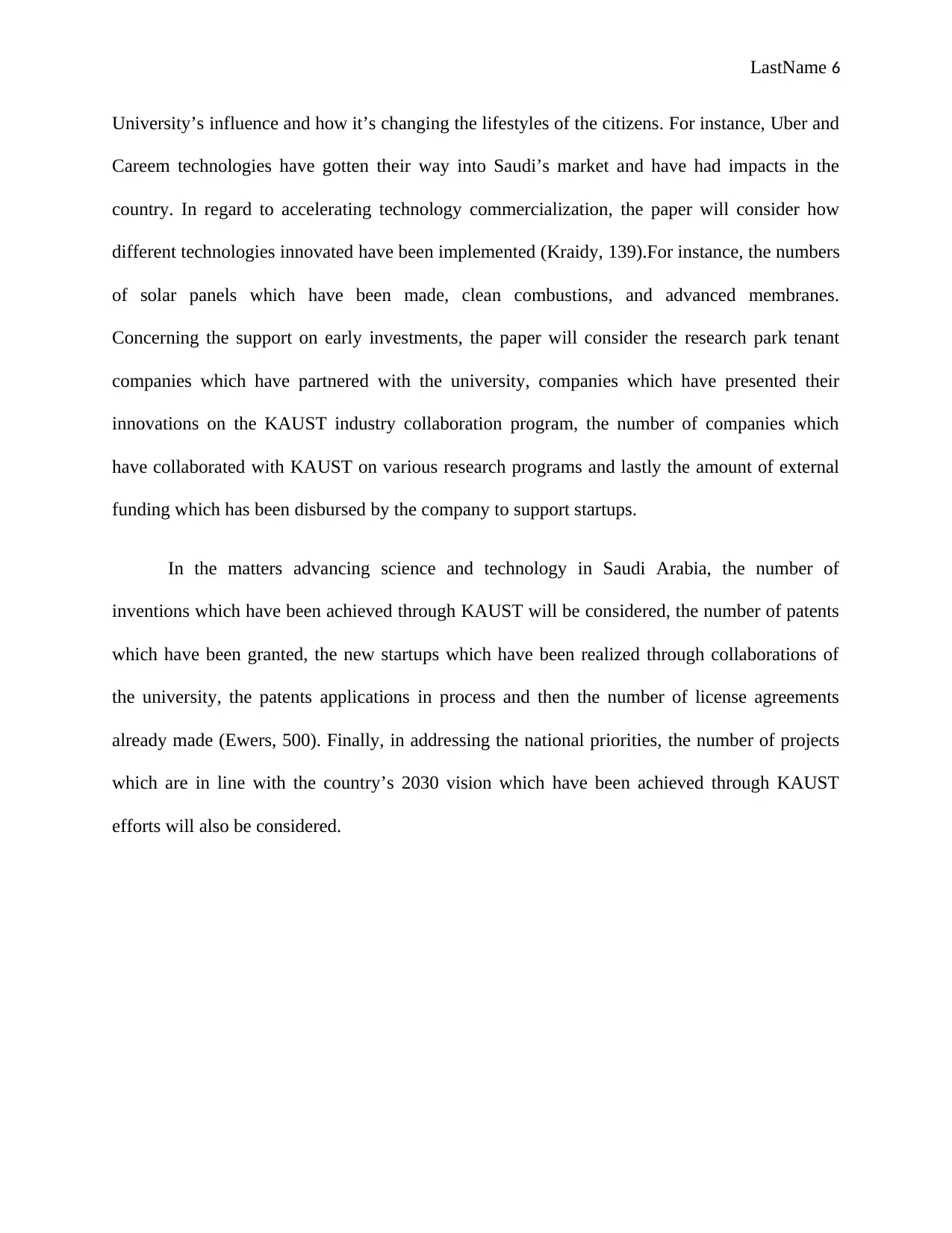
LastName 6
University’s influence and how it’s changing the lifestyles of the citizens. For instance, Uber and
Careem technologies have gotten their way into Saudi’s market and have had impacts in the
country. In regard to accelerating technology commercialization, the paper will consider how
different technologies innovated have been implemented (Kraidy, 139).For instance, the numbers
of solar panels which have been made, clean combustions, and advanced membranes.
Concerning the support on early investments, the paper will consider the research park tenant
companies which have partnered with the university, companies which have presented their
innovations on the KAUST industry collaboration program, the number of companies which
have collaborated with KAUST on various research programs and lastly the amount of external
funding which has been disbursed by the company to support startups.
In the matters advancing science and technology in Saudi Arabia, the number of
inventions which have been achieved through KAUST will be considered, the number of patents
which have been granted, the new startups which have been realized through collaborations of
the university, the patents applications in process and then the number of license agreements
already made (Ewers, 500). Finally, in addressing the national priorities, the number of projects
which are in line with the country’s 2030 vision which have been achieved through KAUST
efforts will also be considered.
University’s influence and how it’s changing the lifestyles of the citizens. For instance, Uber and
Careem technologies have gotten their way into Saudi’s market and have had impacts in the
country. In regard to accelerating technology commercialization, the paper will consider how
different technologies innovated have been implemented (Kraidy, 139).For instance, the numbers
of solar panels which have been made, clean combustions, and advanced membranes.
Concerning the support on early investments, the paper will consider the research park tenant
companies which have partnered with the university, companies which have presented their
innovations on the KAUST industry collaboration program, the number of companies which
have collaborated with KAUST on various research programs and lastly the amount of external
funding which has been disbursed by the company to support startups.
In the matters advancing science and technology in Saudi Arabia, the number of
inventions which have been achieved through KAUST will be considered, the number of patents
which have been granted, the new startups which have been realized through collaborations of
the university, the patents applications in process and then the number of license agreements
already made (Ewers, 500). Finally, in addressing the national priorities, the number of projects
which are in line with the country’s 2030 vision which have been achieved through KAUST
efforts will also be considered.
⊘ This is a preview!⊘
Do you want full access?
Subscribe today to unlock all pages.

Trusted by 1+ million students worldwide
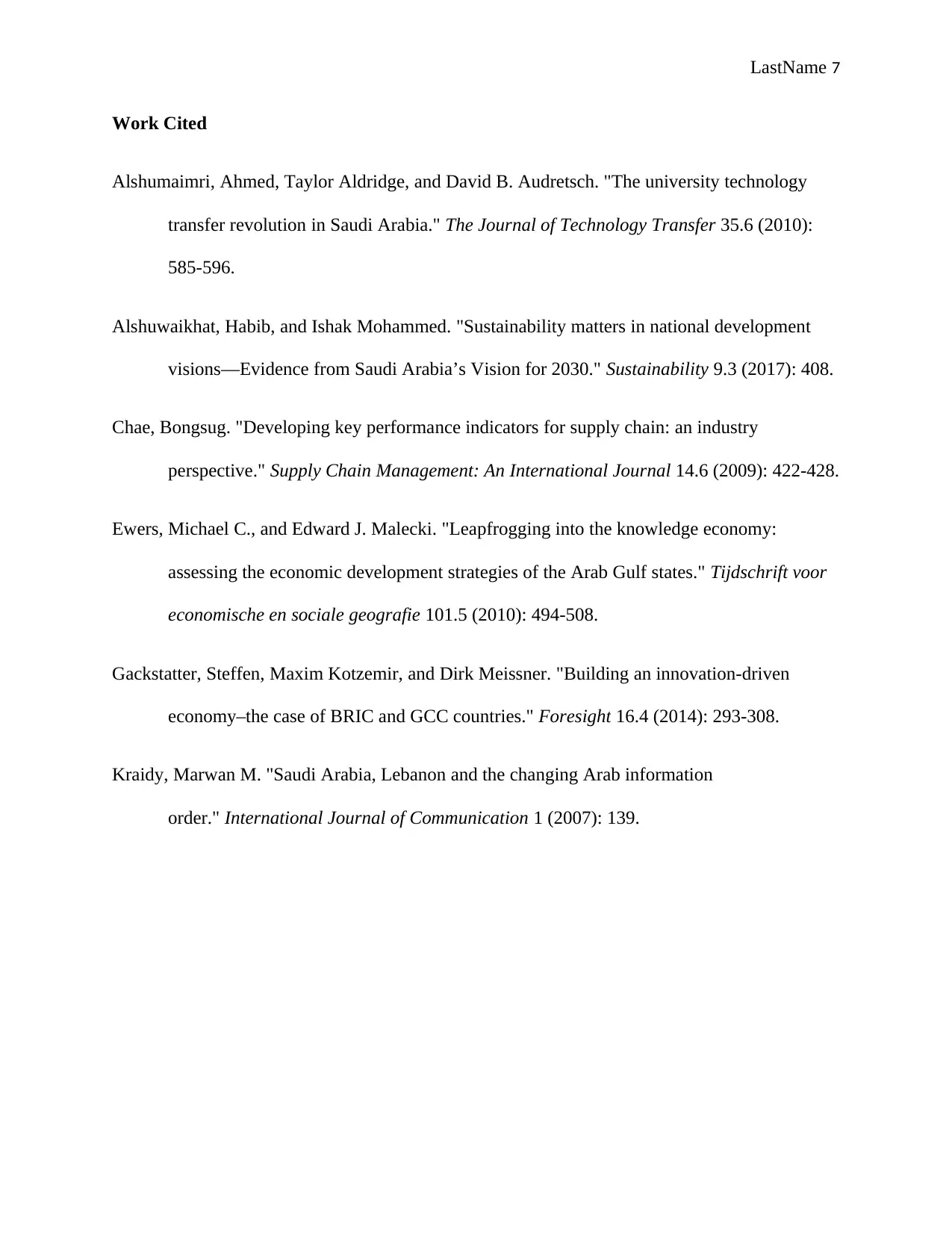
LastName 7
Work Cited
Alshumaimri, Ahmed, Taylor Aldridge, and David B. Audretsch. "The university technology
transfer revolution in Saudi Arabia." The Journal of Technology Transfer 35.6 (2010):
585-596.
Alshuwaikhat, Habib, and Ishak Mohammed. "Sustainability matters in national development
visions—Evidence from Saudi Arabia’s Vision for 2030." Sustainability 9.3 (2017): 408.
Chae, Bongsug. "Developing key performance indicators for supply chain: an industry
perspective." Supply Chain Management: An International Journal 14.6 (2009): 422-428.
Ewers, Michael C., and Edward J. Malecki. "Leapfrogging into the knowledge economy:
assessing the economic development strategies of the Arab Gulf states." Tijdschrift voor
economische en sociale geografie 101.5 (2010): 494-508.
Gackstatter, Steffen, Maxim Kotzemir, and Dirk Meissner. "Building an innovation-driven
economy–the case of BRIC and GCC countries." Foresight 16.4 (2014): 293-308.
Kraidy, Marwan M. "Saudi Arabia, Lebanon and the changing Arab information
order." International Journal of Communication 1 (2007): 139.
Work Cited
Alshumaimri, Ahmed, Taylor Aldridge, and David B. Audretsch. "The university technology
transfer revolution in Saudi Arabia." The Journal of Technology Transfer 35.6 (2010):
585-596.
Alshuwaikhat, Habib, and Ishak Mohammed. "Sustainability matters in national development
visions—Evidence from Saudi Arabia’s Vision for 2030." Sustainability 9.3 (2017): 408.
Chae, Bongsug. "Developing key performance indicators for supply chain: an industry
perspective." Supply Chain Management: An International Journal 14.6 (2009): 422-428.
Ewers, Michael C., and Edward J. Malecki. "Leapfrogging into the knowledge economy:
assessing the economic development strategies of the Arab Gulf states." Tijdschrift voor
economische en sociale geografie 101.5 (2010): 494-508.
Gackstatter, Steffen, Maxim Kotzemir, and Dirk Meissner. "Building an innovation-driven
economy–the case of BRIC and GCC countries." Foresight 16.4 (2014): 293-308.
Kraidy, Marwan M. "Saudi Arabia, Lebanon and the changing Arab information
order." International Journal of Communication 1 (2007): 139.
1 out of 7
Your All-in-One AI-Powered Toolkit for Academic Success.
+13062052269
info@desklib.com
Available 24*7 on WhatsApp / Email
![[object Object]](/_next/static/media/star-bottom.7253800d.svg)
Unlock your academic potential
Copyright © 2020–2025 A2Z Services. All Rights Reserved. Developed and managed by ZUCOL.